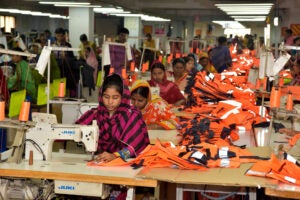|
On August 30, the WITA Academy will host an online workshop on Artificial Intelligence and Trade Policy. Information can be found here and below.
AI can play a vital role in monitoring compliance, analysing trends, and assessing the impact of policies. It provides transparency and engenders trust and accountability. AI-driven decisions and recommendations produce credible, far-reaching results. It can tell us where to seek proof of reliability, raise red flags, and shed light on previously invisible interconnections of the global economy. It assists in furthering our understanding of the complexities of trade dynamics.
But it’s crucial to see AI for what it is: a tool for augmenting human capabilities, not replacing them. Take this example. Over 200 million bills of lading, crucial papers in international trade, were recently reviewed by the International Centre for Trade Transparency (ICTTM). It found that 13.6 percent contained at least one error. The OECD decrees that 2.5 percent of global trades, and up to 5.8 percent of EU imports, are counterfeit. The documents provide particulars about country-of-origin, product codes and descriptions, quantities, and costs. Certifications, health and safety requirements, regulatory controls, anti-dumping measures, and taxation are all set by the data collected.
…Applying AI to international trade provides a workable answer to the growing difficulties and risks associated with internationally integrated markets. By embracing it, we are not advocating for unquestioning faith in an unknown system. We are suggesting its use as a tool to draw focus to specific areas. If we continue to adopt and use AI with a zero-trust, verify-and-confirm methodology, the transparency, accuracy, and efficiency it can bring could become essential in navigating the global commerce system.
Right now, at the intersection of science and business, artificial intelligence presents a once-in-a-generation opportunity. Used wisely, it has the potential to help overcome some entrenched problems. Its potential extends beyond the cutting of human labour or the generation of otherwise unpredictable results. It gives us a new perspective, an analytical tool that could radically alter how we think about international trade. It could help our economies to flourish in ways that are beneficial to all involved.
There’s no tolerance for AI hallucinations here. Precision, clarity, and faith in human scrutiny are front and centre. ESG reporting is becoming the new norm. Interoperability affords legal protection and a process that safeguards SMEs and banks. Collaborative efforts such as Project Perseus bring together technology, finance, and policy to unlock sustainable access for SMEs via data-sharing. This is critical for stakeholders in the business and banking worlds.
Nationally built systems in technological and political silos must be avoided to combat these challenges. Collaborative efforts between nation states would enable a comprehensive understanding of patterns and targeted strategies. Artificial intelligence should be seen as an instrument that shows us the bigger picture of a vast chain over which no single country, or corporate, should ever have total control.
So, where do governments, regulators, and the private sector go from here? Frameworks and processes are in place to deliver success — and the time for theory is over.
|
|
Despite the Biden Administration’s adoption of the EU’s ‘de-risking’ term, and admitting the infeasibility of truly decoupling, they are still trying to divide major parts of the world economy, including China from the EU. Along with export controls and investment reviews, their big initiative is the subsidies war in manufacturing that they have launched through the IRA and CHIPS Acts.
The evidence supports the idea that government spending on R&D, worker training, infrastructure, and expedited regulation of innovations is positive. Once politicians start handing out money to individual companies for specifically located production, though, and they start favouring those companies over potential rivals – they have a public investment to protect, after all – it becomes a bad dynamic.
The core problem is that there is nothing for a company like having the state as your de facto guarantor. A host of bad things happen to society as a result. On the international front it leads to retaliation, shutting out of poor countries, reduced adoption of new technologies, and corruption. But the domestic effect on any country that goes down this path is worse.
The society ends up with entrenched incumbent companies becoming a political sacred cow, as we have seen with state owned enterprises and banks in China. You cannot reduce the employment, or shift the location, or let competition come in from either the outside or the inside. You have accumulating unfairness from incumbent companies’ political weight being thrown around. You crush new entrants and dynamism.
So, trying to replicate entire supply chains is enormously inefficient. You must pay some insurance premium to create more resilient supply chains, but this takes it much too far. Trying to achieve self-sufficiency in any major industry that is not a simple extractive one, like a mine, is self-defeating.
The reason is the value of diversification. Yes, attenuated supply chains, dependent upon potentially hostile hosts, are a vulnerability. But so is having all or most of one’s production at home, subject to natural disasters, climate shifts, unstable politics, domestic terrorism, and undependable or deficient production due to the corruption of too big to fail local producers. Russia and North Korea have worked very hard to be self-sufficient, with limited supply chains, and it has not worked out well for them.
The real damage from decoupling and conflict between increasingly entrenched US, China and EU economic blocks is not so much trade barriers, bad as they are, but reduced productivity growth. We would see a bottling up of savings in economic blocs that do not move around and so get lower more volatile returns. There will be less diversification both financially and in inputs, including of ideas and business practices, along with less competition, which directly diminish productivity. We would also see further restrictions of migration, foreign direct investment, flows of information and technology, once the economic nationalism is state policy.
|
|
|
For yet another month, China’s merchandise trade exports declined, falling 14.5% year-on-year in July to $281.8 billion. The drop was driven by a weaker economy and an ongoing realignment in global trade. Companies are seeking alternative manufacturing bases to China, to lower costs and temper political risk, and reducing their foreign direct investment that’s underpinned the Chinese economy for the first two decades of this century.
And China’s traditional trading partners are simply buying less because their people have less money to spend. Exports to the U.S. fell 22.7% to $42.3 billion, shipments to Europe fell 20.7% to $42.4 billion, and sales to ASEAN countries dropped 19.2% to $41.8 billion. The weaker demand for goods, as consumer run out of stimulus money and spend more on rent and food, has punctured manufacturing throughout Asian factories, according to surveys of purchasers.
That’s why the UN said in a June report that “the outlook for global trade in the second half of 2023 is pessimistic”, a sobering outlook for trade-dependent countries in Asia.
But China is such a big economy – the second largest in the world by GDP and the planet’s top exporter — that there are always pockets of growth, or at least, of more moderate decline, that offer a more nuanced understanding of the global economy.
The bad news has prompted economists to suggest that Beijing implement stimulus measures such as bonds to pay for spending on roads and other infrastructure, which would boost imports of iron ore and other industrial commodities.
To be sure, there are other parts of China’s industry that aren’t faring as bad as the top-line numbers, notably in technology.
Exports of mobile phones increased 2.2% to $9.2 billion. That’s 63.4 million phones. Exports of household appliances dropped only 2.6% to $7.4 billion. And, of course, its automotive sector keeps motoring on. Exports of motor vehicles leapt 83.5% to $8.8 billion. China this year replaced Japan as the world’s top exporter of automobiles.
|
|
|
|
Excerpts from Canada’s Tarriff Review: Not Woke, Broke by Fauzya Moore.
Half a century ago, these “pink tariffs” protected TAF industries in Canada from competition. They are no longer needed. Canada has labour shortages, not labour surpluses. Most TAF industries offshored by the 1990s to labour-surplus countries. Canada imports 95 per cent of its apparel. If necessary, the remaining highly specialized five per cent made-in-Canada products can be protected by tariffs on individual tariff lines. Budget 2023 claims that graduating countries will help Canada’s FTA negotiations. There is little evidence of that, and alternatives exist. And inflation post-COVID provides a strong economic rationale for reducing pressures on Canadian consumers by leaving LDC tariffs at zero while reducing the tariffs on non-LDC TAF imports.
Eons ago, the GPT (GSP in most other countries) was created to help newly independent developing countries gradually acquire market access to developed market economies. During colonialism, tariffs and taxes suppressed industrialization in many colonies, but not in all dominions. The destruction of the 1,000-year-old cotton producing and exporting businesses in India by the imposition of high tariffs and taxes is an example. Cotton production essentially relocated to industrializing Europe behind high tariff walls. The chakra in India’s flag not only represents spirituality, but it evolved from a spinning wheel. One of India’s earliest nationalist struggles was to re-shore textile industries to India.
GPT/GSP schemes were flawed from the beginning because most did not address tariffs on TAF industries. For example, Canada never had a GPT on TAF; it had just a general MFN tariff of 17 per cent. Long after independence, tariffs and other trade restrictions in main TAF export markets remained high, either to protect labour in developed countries or to accumulate revenue for governments. In the developing world, they slowed down a critical part of the industrialization in the shift from agriculture to labour-intensive industries.
Finance Canada is proposing a GPT+ scheme similar to the EU’s scheme for graduating countries. It is consulting on a package: a lower tariff in exchange for the right to review labour and environmental standards in eligible developing countries. Graduating LDCs – Bangladesh, Laos and Nepal – are eligible for the scheme and, in a useful move, Finance has selected as eligible some lower middle-income TAF exporting countries: Sri Lanka, Pakistan, Egypt, El Salvador and Kenya.
If the proposed preferential tariff is anything higher than zero, it will have incremental costs to consumers and producers. Pakistan, Egypt and Sri Lanka all export apparel to Canada but so far, their exports are a small fraction of Bangladesh’s market share. Further, most exporting countries and SMEs develop industrial clusters by evolving along the TAF spectrum to footwear, headwear and other spin-offs. Non-apparel TAF goods appear to be excluded from the proposed preferential tariff and that exclusion could mean additional costs to Canadian consumers and businesses and continued low wages to workers. The average MFN tariff on footwear is around 18 per cent.
|
|
|




